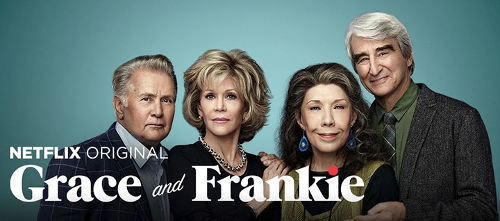
On the eve of the release of season 3 of Orange is the New Black, and while the rest of the world’s feminist media critics still struggle to sort out Sense8, I decided to take a look at one of Netflix’s least-buzzed-about original series: Grace and Frankie, which premiered in May to little fanfare outside a late night tweet from one Miley Cyrus. Grace and Frankie stars Jane Fonda and Lily Tomlin as the title characters, whose husbands Robert and Sol (Martin Sheen and Sam Waterston) leave them for each other after admitting to a 20-years-running affair. Grace and Frankie move into the beach house the couples shared and forge an unlikely friendship while navigating the single life for septuagenarians. The show has its charms, such that I might have watched the entire season without journalistic integrity as a motivation, but Grace and Frankie let me down in a lot of ways:

1. The premise turns out to be rather boring. It is easy to imagine a late 90s pitch meeting, where “It’s like The First Wives Club—but their exes are gay. For each other!” is met with applause and pats on the back for cooking up something so “edgy.” And given that the creators of Grace and Frankie are 90s sitcom powerhouses Marta Kauffman (Friends) and Howard J. Morris (Home Improvement), you might expect something embarrassingly old-fashioned along those lines. Fortunately this is not the case, but Grace and Frankie overcorrects: everyone is so accepting of Robert and Sol coming out, and breaking up their marriages to do so, that most of the dramatic interest is obliterated.
2. This blandness coincides with an unfortunate case of bi-erasure. No one ever uses the B-word, even though Robert and Sol seem to have truly loved their wives romantically and sexually before falling for each other. [Spoiler alert!] A late-episode plot development will probably force reconsideration of this issue in season 2, but I’d rather bisexuality not be addressed through a negative stereotype like unfaithfulness.

3. The odd couple dynamic between Grace and Frankie is alarmingly unimaginative. One is a WASP and one is a hippie! Can you imagine the peyote-fueled hijinx that must follow?
4. It leans heavily on the HILARITY of old ladies saying dirty words while rarely bothering to weave those dirty words into otherwise funny dialogue.

5. And yet the series is remarkably chaste outside of its discussion of sandy vaginas and yam-based personal lubricants. Grace and Frankie wants to be celebrated for acknowledging the sex lives of seniors, but the most sexual chemistry we see on screen is between Lily Tomlin and the Scripps National Spelling Bee.
6. The characters are in the very boring As-Perpetually-Seen-on-TV Upper Upper Middle Class, and the show never engages with how the characters’ economic privilege intersects with their aging or sexual identity.
7. The first episode rips off the How to Get Away With Murder scene where Annalise removes her wig and makeup, which a) is significantly less meaningful with a white woman b) undermined by the drastically incomplete removal of Jane Fonda’s makeup. This is her “deconstructed” look:

8. And for a show whose main selling point is celebrating women of a certain age, it is a shame they felt the need to shave eight years off Jane Fonda’s age and five years off Lily Tomlin’s to make both protagonists 70 years old. And then have Grace list her age as 64 on a dating website.
9. The one person of color in the cast is the least-developed character. That’s one of Sol and Frankie’s adopted sons, Nwabudike “Bud” Bergstein (Baron Vaughn). It feels like the one chance we get to know him is through his chemistry with his future sister-in-law Brianna (June Diane Raphael), but that relationship is sidelined in favor of…

10. The creepy “I stalk you because our love is so pure” “connection” between the other cross-section of future step-siblings: Mallory (Brooklyn Decker, who has surprising comic timing) and Coyote (Ethan Embry, who is disturbingly 20 years older than he was in Empire Records WHERE DOES TIME GO). Mallory has a hunky doctor husband and Coyote is a drug-addicted loser, but I think we’re still supposed to root for those two crazy kids to work it out? I am only rooting for a restraining order.

11. And June Diane Raphael is as underused as she normally is, in keeping with her place as television’s Judy Greer.
12. There is an episode in which some of the main characters are trapped in an elevator and one of the characters unexpectedly delivers a baby outside of a hospital setting, but these two storylines occur at different times and places. How dare you tease us with the cliché singularity, show, and not follow through.

13. Dolly Parton does not guest star, denying us the 9 to 5 reunion we want—no, need—no, DESERVE. This better be corrected in season 2.
Robin Hitchcock is a writer based in Pittsburgh who can personally attest to the deliciousness of whiskey-soaked vanilla ice cream.

I agree with your points, and the deliciousness of whisky soaked ice cream, but I still really enjoyed the series. I’m hoping it will acknowledge some of its failings next season because it’s so important to have media with older women as the protagonists.
From someone who was married 27 years before finding out her mate was gay, I can truly relate to this series. Only someone experiencing the pain, humiliation and betrayal can really rally for such a series. I do not consider it a bitch flick.
You do realize this is actually a comedy Show and not a documentary of edler peoples sex life?